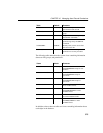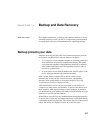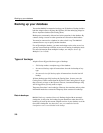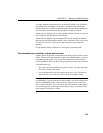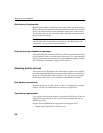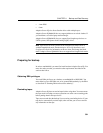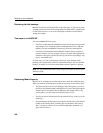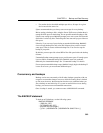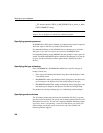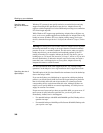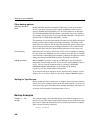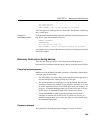
CHAPTER 11 Backup and Data Recovery
383
• For stacker devices that hold multiple tape drives, all tapes for a given
device must be the same size.
Sybase recommends that you always start a new tape for every backup.
Before starting a backup to disk, Adaptive Server IQ first tests whether there is
enough disk file space for the backup. For an operator-attended backup to disk,
if there is not enough space,
BACKUP prompts you to move some files from the
disk before it writes any data. The backup does not start until you provide more
disk space.
Likewise, if you run out of space during an attended disk backup,
BACKUP
closes all open backup files and waits until it detects that you have cleared
some space. Then it restarts with new backup files. You can also stop the
backup if you prefer.
By default, you must provide at least 8KB of free disk space before the backup
resumes.
Unattended backup cannot prompt you to provide more space. If enough space
is not available, unattended backup fails.
BACKUP treats size estimates
differently for unattended backups. See “Unattended backup” for details.
For an operator-attended backup to tape,
BACKUP simply begins the backup. If
it runs out of room, you must mount additional tapes.
Concurrency and backups
Backups can be run concurrently with all other database operations with one
exception: no metadata changes can occur while the Catalog Store is backed
up. Be aware, however, that transactions that have not committed when you
start a backup are not backed up. If a system or media failure occurs during
backup, you cannot restore uncommitted transactions.
Once a backup is started, you cannot execute a
CHECKPOINT command.
The BACKUP statement
To back up an IQ database, use the following syntax:
BACKUP DATABASE
...[ CRC ON | OFF ]
...[ ATTENDED ON | OFF ]
...[ BLOCK FACTOR
integer
]
...[ { FULL | INCREMENTAL | INCREMENTAL SINCE FULL } ]



